There are 300 kilometres to walk in 13 days (8 days by Mountain Bike), to complete a fascinating spiritual journey that begins and ends in the city and stops throughout places devoted to Our Lady in the Seriana Valley and the northern end of Lake Iseo.
It starts from the Church of Santa Maria delle Grazie in the lower town and after going through spectacular natural scenery along the Serio river and Lake Iseo, it winds back to Bergamo. The last stop is in the upper town in the Santa Maria Maggiore Basilica.
Gabriella Castelli, Pilgrim and Hospitalera on the Camino de Santiago, and Giovanni Battista Merelli from Vertova, an connoisseur of the paths that wind between Bergamo and Valbondione, have mapped with passion and extreme care this itinerary, inspired by the Camino Santiago de Compostela, the most famous European walk.
The symbol that identifies the path is a blue four-leaf clover on a square yellow background, encircled by the 12 stars of the United Europe. The four petals of the four-leaf clover symbolise the four themes of the journey: art, nature, spirituality and tradition.
A passport accompanies the pilgrim along the way, gives them the status of a wayfarer of the Walk and allows them to obtain stamps and access to the reception facilities along the Alta Via Walk. The Walk has received the concession of Grace, an official document that is delivered to each pilgrim at the end of the journey.
For more information on the journey and on the accomodation facilities (hostels, B&Bs etc.) visit the website altaviadellegrazie.com, to request a passport write to altaviadellegrazie@gmail.com or call 348 4527583.
The Alta Via delle Grazie Walk also connects, towards the west, to the Camino di Sant'Agostino
There are 300 kilometres to walk in 13 days (8 days by Mountain Bike), to complete a fascinating spiritual journey that begins and ends in the city and stops throughout places devoted to Our Lady in the Seriana Valley and the northern end of Lake Iseo.
It starts from the Church of Santa Maria delle Grazie in the lower town and after going through spectacular natural scenery along the Serio river and Lake Iseo, it winds back to Bergamo. The last stop is in the upper town in the Santa Maria Maggiore Basilica.
Gabriella Castelli, Pilgrim and Hospitalera on the Camino de Santiago, and Giovanni Battista Merelli from Vertova, an connoisseur of the paths that wind between Bergamo and Valbondione, have mapped with passion and extreme care this itinerary, inspired by the Camino Santiago de Compostela, the most famous European walk.
The symbol that identifies the path is a blue four-leaf clover on a square yellow background, encircled by the 12 stars of the United Europe. The four petals of the four-leaf clover symbolise the four themes of the journey: art, nature, spirituality and tradition.
A passport accompanies the pilgrim along the way, gives them the status of a wayfarer of the Walk and allows them to obtain stamps and access to the reception facilities along the Alta Via Walk. The Walk has received the concession of Grace, an official document that is delivered to each pilgrim at the end of the journey.
For more information on the journey and on the accomodation facilities (hostels, B&Bs etc.) visit the website altaviadellegrazie.com, to request a passport write to altaviadellegrazie@gmail.com or call 348 4527583.
The Alta Via delle Grazie Walk also connects, towards the west, to the Camino di Sant'Agostino
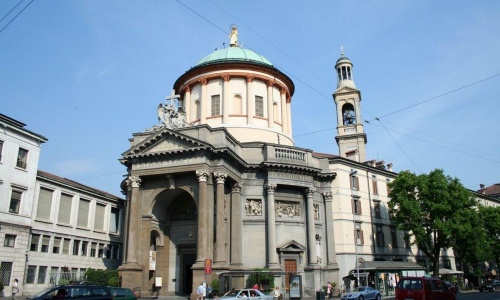
The first 22km will take you from Bergamo to Selvino. The walk starts at the Church of Santa Maria delle Grazie in Bergamo’s lower town and you will arrive in Selvino, stopping at the Sanctuary of Our Lady of Monte Perello, in the town of Algua. At the end of the first day, you will find refreshments and accommodation at the Hotel Marcellino in Selvino, or the Poieto Refuge or Baita de l'Angel B&B in Aviatico.
The first 22km will take you from Bergamo to Selvino. The walk starts at the Church of Santa Maria delle Grazie in Bergamo’s lower town and you will arrive in Selvino, stopping at the Sanctuary of Our Lady of Monte Perello, in the town of Algua. At the end of the first day, you will find refreshments and accommodation at the Hotel Marcellino in Selvino, or the Poieto Refuge or Baita de l'Angel B&B in Aviatico.
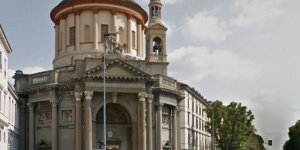
The church of Santa Maria delle Grazie is located in Bergamo on Viale Papa Giovanni XXIII, near the propylaea. Coming from the train station is the first place of worship that you come across in the city.
The building is sacred and rich in history: it was founded in 1422 by San Bernardino as a Franciscan convent. In the mid-nineteenth century, due to urban reorganisation in the city that involved the construction of a large avenue that connected the station to Porta Sant'Agostino, the church was demolished and then rebuilt in a slightly different location.
The current neoclassical style Greek Cross structure of the church, is due to the architect Antonio Preda, who managed to create an important well placed structure in a new position in the city, thus making the ‘delle Grazie’ monumental complex the heart of the city.
The cloister and many of the artworks from the historic complex still exist, such as, the miraculous fresco of the Holy Jesus on the wooden altar by Caterina Caniana (1761), "Madonna and Saints" by Giambettino Cignaroli (1752), "Madonna and San Diego" by Enea Salmeggia (1594) and many other frescoes. The pictorial decoration of the church, which culminates in the Gloria di Maria (1865-68) painted in the dome, is the work of Enrico Scuri, director of the Accademia Carrara School of Painting.
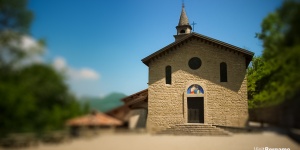
Formerly called the "Oratory of Our Lady and Elizabeth in the Wood of Perello", the Sanctuary of the Our Lady of Monte Perello is located in the Parish of Algua, on the road from Selvino to the Seriana Valley.
Composed of three overlapping churches, it stands on the slopes of Mount Perello, from which it takes its name, in an enchanting setting immersed in the green of the woods and inside it is rich in works of art and antique furniture.
It is one of the oldest sanctuaries in Bergamo: the structure dates back to the 16th century and its origin dates back to 1413, when the Blessed Virgin Mary appeared to a local farmer. On July 2nd, the anniversary of the Apparition is celebrated.
The Shrine is opened on Easter Monday and closed on November 1st, All Saints Day. It is open every day during the summer months and only on Saturday afternoons and Sundays during the rest of the year.
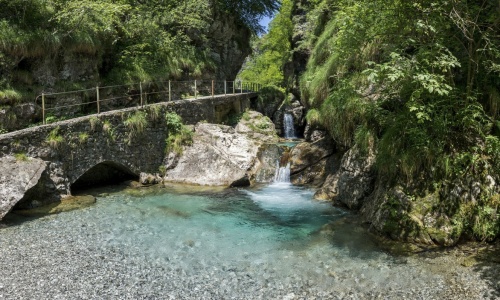
From Selvino you will leave for Vertova, and during the 16km path you can admire Val de Gru, a place of particular naturalistic attraction, off the beaten track that preserves an old peasant world and the Vertova Valley, a treasure trove of natural beauty. At the end of the route you can find hospitality at the Bed and Bike La Valvertova and eat at special prices at San Lorenzo restaurant and pizzeria.
From Selvino you will leave for Vertova, and during the 16km path you can admire Val de Gru, a place of particular naturalistic attraction, off the beaten track that preserves an old peasant world and the Vertova Valley, a treasure trove of natural beauty. At the end of the route you can find hospitality at the Bed and Bike La Valvertova and eat at special prices at San Lorenzo restaurant and pizzeria.
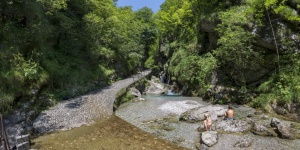
This natural jewel of Seriana Valley takes up almost 12 km among the mounts Cavlera, Suchello and Alben.
Cars are not allowed here: if you want to explore the heart of Vertova Valley you will have to walk along mule tracks and pathways. But don’t worry: the main trail is very easy! It is also extremely charming, as well: it goes along the creek that creates numerous small waterfalls and shiny natural pools carved in the dolomitic rocks, called “marmitte dei giganti”.
The Valley also features a lush vegetation, with ash trees, maples, beech trees and fruit trees such as chestnuts. What are you waiting for? Pack your rucksack and go!
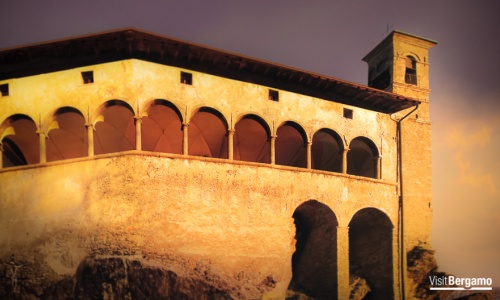
On the third day, from Vertova we will arrive at the Sanctuary of Madonna del Frassino in Oneta. On this 17km route do not miss the Sanctuary of San Patrizio and the village of Barbata, characterised by only a few houses and the Church of Madonna della Mercede, surrounded by nature. Once arrived at your destination you can rest in an apartment dedicated to pilgrims. Next to the Sanctuary, at the Trattoria Frassino you can dine with an excellent typical menu for pilgrims.
On the third day, from Vertova we will arrive at the Sanctuary of Madonna del Frassino in Oneta. On this 17km route do not miss the Sanctuary of San Patrizio and the village of Barbata, characterised by only a few houses and the Church of Madonna della Mercede, surrounded by nature. Once arrived at your destination you can rest in an apartment dedicated to pilgrims. Next to the Sanctuary, at the Trattoria Frassino you can dine with an excellent typical menu for pilgrims.
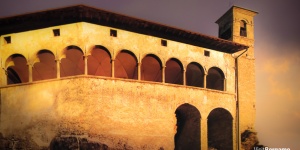
Located on a hill near Colzate, visible as you go along Valle Seriana between Vertova and Casnigo, the sanctuary of San Patrizio includes a very old little church of the end of the XIII century.
Vertically isolated so to seem an ancient small fortress, the sanctuary was built in 1580 and finished about twenty years later.
Every year on occasion of Corpus Christi day, in Gandino a grand procession takes place to which take part the confraternities and the inhabitants from the whole area. In Gandino there is the gorgeous Basilica di Santa Maria Assunta, which has in its museum a considerable artistic heritage.
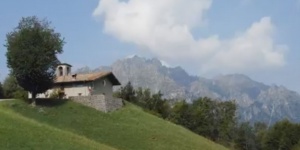
Located in Bondo di Colzate, the Church of Barbata is dedicated to Our Lady of Mercede and dates back to the sixteenth century, built by the Trinitarians of the Mercede. It is located in a panoramic position and from the small beautiful churchyard you can admire the different peaks of the Orobic Prealps and the Riso Valley.
The current bell tower is dated 1500 while the small church, built on a previous chapel, was built in 1571, the date is engraved on the arched stone portal.
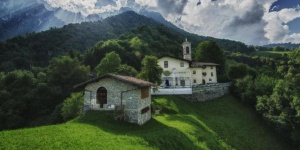
In the municipality of Oneta, in the Riso Valley, the Sanctuary of Madonna del Frassino (Our Lady of the Ash Tree) is located on the slopes of Mount Alben, on a hill at an altitude of 954 metres. The name originates from "Frasen", a hill where there was a majestic ash tree and, thus, the inhabitants began to call the place with the specific name of the tree.
Given the considerable distance from the village of Oneta, the sanctuary is considered a place of peace and serenity and the structure is surrounded by a large panoramic churchyard, from which it is possible to admire the Riso Valley’s beauty.
The Sanctuary of Madonna del Frassino, dating back to 1502, recalls the apparition of Our Lady in 1512 to the young Pierina Carobbio, known to all as Petruccia and houses valuable frescoes and sculptures.
On request it is possible to organise a guided tour. Indoor and outdoor picnic areas and a meeting room for up to 30 people.
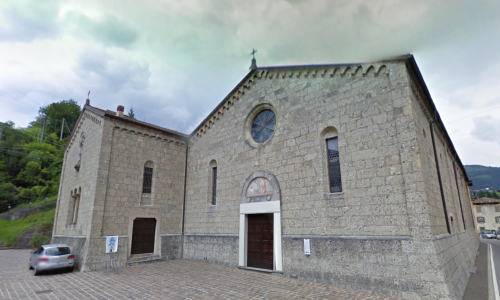
The goal of the fourth day is Parre. From the sanctuary, you pass through the Zambla Pass and arrive in Gorno. Along the Upper Serio path you reach Premolo, where you can stop or continue and visit the Sanctuary of Madonna delle Lacrime in Ponte Nossa and arrive in Parre. The credential can be stamped in Premolo in the Museum of the Crypt of Don Antonio Seghezzi, at the Sanctuary of Madonna delle Lacrime in Ponte Nossa, at the Parre Proloco and in the reception areas.
The goal of the fourth day is Parre. From the sanctuary, you pass through the Zambla Pass and arrive in Gorno. Along the Upper Serio path you reach Premolo, where you can stop or continue and visit the Sanctuary of Madonna delle Lacrime in Ponte Nossa and arrive in Parre. The credential can be stamped in Premolo in the Museum of the Crypt of Don Antonio Seghezzi, at the Sanctuary of Madonna delle Lacrime in Ponte Nossa, at the Parre Proloco and in the reception areas.
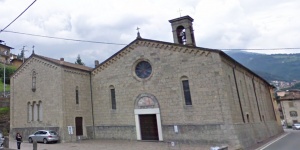
In Ponte Nossa, in Campolongo, we find the Sanctuary of Madonna delle Lacrime, also called "Madonna di Campolongo".
It is the first lacrimation of blood from a Marian image duly documented in the history of the Universal Church: according to tradition, on June 2nd, 1511, a shepherdess from the village staring at the picture, saw the face of the Madonna change to tear blood. The miraculous image of Our Lady is still kept in the Sanctuary, along with the sixteenth-century polyptych attributed to the Vivarini workshop and several votive tablets dedicated to Our Lady, tangible signs of popular belief that have made the Sanctuary of Ponte Nossa one of the most important destinations in the Bergamo area for Marian pilgrimages.
However, what captures the most attention is certainly the long embalmed crocodile placed above the right-hand entrance: tradition has it that the great reptile was a gift from a merchant at the end of the sixteenth century.
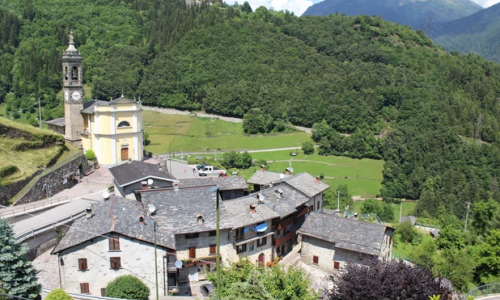
On the fifth day, the 18km route will take you from Parre to Novazza, a hamlet in Valgoglio. You will visit the evocative Sanctuary of the Holy Trinity and pass on the characteristic "dancing bridge" of Villa d’Ogna. You will continue passing through the village of Bani di Ardesio until you reach Novazza to end the journey and find hospitality.
On the fifth day, the 18km route will take you from Parre to Novazza, a hamlet in Valgoglio. You will visit the evocative Sanctuary of the Holy Trinity and pass on the characteristic "dancing bridge" of Villa d’Ogna. You will continue passing through the village of Bani di Ardesio until you reach Novazza to end the journey and find hospitality.
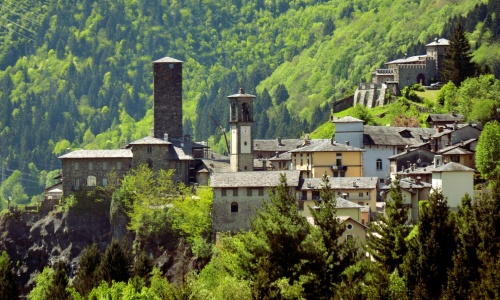
On the sixth day, we leave Novazza towards the next destination, Lizzola, a hamlet in Valbondione. Along the way you go through Gromo which, thanks to its ancient historic centre and its landscape, has been awarded the title of "most beautiful village in Italy". You can admire the beauties scattered throughout the streets of the village and the parish church houses numerous prestigious artworks. Continue towards Valbondione and the characteristic mountain village of Maslana. At the end of the path you will find hospitality at the Gioan hotel in Lizzola.
On the sixth day, we leave Novazza towards the next destination, Lizzola, a hamlet in Valbondione. Along the way you go through Gromo which, thanks to its ancient historic centre and its landscape, has been awarded the title of "most beautiful village in Italy". You can admire the beauties scattered throughout the streets of the village and the parish church houses numerous prestigious artworks. Continue towards Valbondione and the characteristic mountain village of Maslana. At the end of the path you will find hospitality at the Gioan hotel in Lizzola.
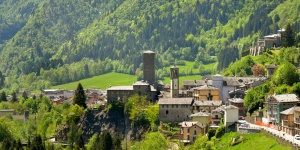
Going up the Seriana Valley, you will find a dark cliff along the street. Gromo is right over there: one of Italy’s most beautiful hamlets.
Go walk across its medieval alleys, and it will be like going back in time. You could even find a smith hammering at his anvil: in fact, during the Middle Age smithies were so numerous here that Gromo started to be called “The little Toledo”, a city renowned for the white weapons manufacture.
Go visit the lovely Museum of White Weapons and Parchments (“Museo delle Armi Bianche e Pergamene”), inside Palazzo Milesi, and discover the beautiful armours and weapons displayed.
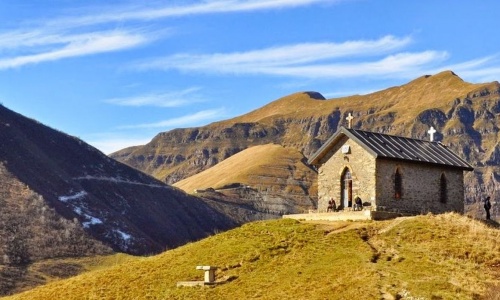
On the seventh day, after reaching the highest point of the Alta Via delle Grazie Walk, the small Church of Madonna Pellegrina at the Manina pass, the descent begins. You will stop in Ardesio, where you will find the Sanctuary of Madonna delle Grazie, one of the best-known points of the entire journey. You can rest at Casa del Pellegrino in Ardesio.
On the seventh day, after reaching the highest point of the Alta Via delle Grazie Walk, the small Church of Madonna Pellegrina at the Manina pass, the descent begins. You will stop in Ardesio, where you will find the Sanctuary of Madonna delle Grazie, one of the best-known points of the entire journey. You can rest at Casa del Pellegrino in Ardesio.
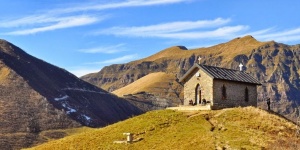
Located at the highest point of the Alta Via delle Grazie Walk, the Church of Madonna Pellegrina is located at 1796m on the Manina Pass, the border between the Seriana Valley and the Scalve Valley. Built in the post-war period between 1948 and 1949, the chapel is characterised by two identical and specular altars, one facing the village of Lizzola and the other towards that of Vilminore. The Church was built in suffrage of the passing of Madonna Pellegrina (in transit towards Lizzola), and was chosen as the protector of the pilgrims on the Alta Via delle Grazie Walk.
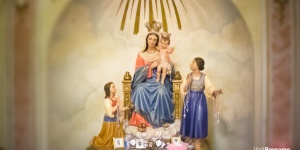
In the small village of Ardesio, at the foot of the Orobie Prealps, rises the majestic Sanctuary of Madonna delle Grazie, an important example of Baroque art in the Seriana Valley. The sanctuary dates back to the seventeenth century and was built in the place where, traditionally, Our Lady appeared to the young Mary and Catherine Salera. The feast of the Apparition falls on June 23rd.
With a large churchyard, the structure’s exterior is very simple but the interior shows its beauty and Baroque richness, with walls and a vault full of decorations and artworks.
There are numerous works of art, sculptures and furnishings that we can admire inside the Sanctuary of Madonna delle Grazie: above all the fresco of the apparition, called this way because it is where Our Lady appeared, the only fresco left of the so-called "Room of the Saints", the room of the Salera family's house that was frescoed by a priest during the 15th century with a series of religious images.
Also noteworthy is the Organ, the work of artisan Giovanni Rogantino from Morbegno that with 1345 pipes and 10 stops is certainly one of the largest organs in the Bergamo area, incomparable to others both in terms of size and wealth of carvings.
The statue of the Madonna with the Child is brought out every year on June 22nd in the Solemn Procession, and many objects are offered as gifts to Our Lady by pilgrims.
The bell tower is 68 metres high, three times the height of the Sanctuary and is made completely from marble.
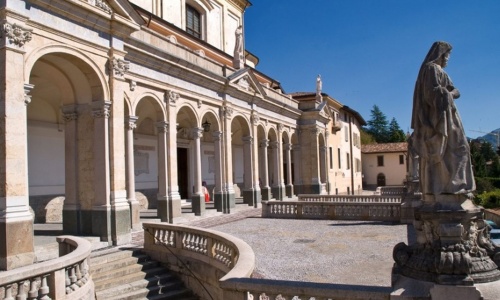
From Ardesio to Castione della Presolana, the eighth day, walking a distance of 20km. In Clusone you will stop at the Sanctuary of Beata Vergine Addolorata del Paradiso, located in the city centre and at the Basilica of Santa Maria Assunta. Do not miss the Oratory dei Disciplini, where you can admire the Dance of Death. On the road that connects Clusone to Rovetta you will reach the Sanctuary of Madonna di Sommaprada. The arrival is scheduled in Castione della Presolana, a medieval village with a historic centre characterised by artistic riches.
From Ardesio to Castione della Presolana, the eighth day, walking a distance of 20km. In Clusone you will stop at the Sanctuary of Beata Vergine Addolorata del Paradiso, located in the city centre and at the Basilica of Santa Maria Assunta. Do not miss the Oratory dei Disciplini, where you can admire the Dance of Death. On the road that connects Clusone to Rovetta you will reach the Sanctuary of Madonna di Sommaprada. The arrival is scheduled in Castione della Presolana, a medieval village with a historic centre characterised by artistic riches.
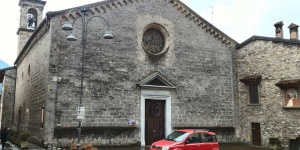
In the historic centre of Clusone is the Church of Paradiso.
Built as an extension of a monastery in the thirteenth century, it owes its modern appearance to various structural and decorative interventions between the eighteenth and twentieth centuries.
Located in Piazza Paradiso, it preserves valuable works of art.
The bare and austere façade conceals an interior that is rich in paintings, chapels and evocative artworks. Of notable beauty is certainly the fifteenth-century fresco depicting Our Lady of Sorrows, a particular and most devout representation of Marian pain, and numerous works by sculptors, engravers and painters from Clusone, including Carpinoni, Cifrondi, Galizzi and Brighenti. The twentieth century Altar of the Visitation, by Virginio Muzio, with the revival of Fantoni's elements is one of the most famous artistic elements.
The façade is made of local stone and, according to tradition, it is claimed that these stones came from some forts, refuge of Guelphs and Ghibellines.
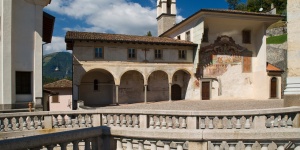
Located in Clusone, in front of Santa Maria Assunta Basilica, the Oratory dei Disciplini is a 14th century medieval building, commissioned by the Confraternity dei Disciplini of Bergamo as the base for its order.
The structure presents itself as a simple structure but has numerous frescoes of great value: the most important fresco is that of the Clusonian painter Giacomo Borlone de Buschis, divided into 5 parts, which represents a synthesis, unique in Europe, of the themes of death at the end of the Middle Ages. We can find the Triumph of Death and the Dance of Death on the outside and the Life of Jesus with the Crucifixion on the outside.
In the Triumph of Death, it is iconographically represented as the ruler to whom everyone submits, while in the lower part of the fresco each character, still alive, with fear and despair finds their skeleton. All this is depicted as a parade in pairs, where the skeleton (the dead) is the double of the living person: it is the renowned Dance of Death, a very popular theme in northern Europe.
The Middle Age was a time of uncertainty and pestilences, but art and aesthetics were important, too! ! All kids of messages were conveyed to the common people by means of images, so that even who could not read was able to understand. That’s why the Clusone’s “Disciplini” monks decided to commission these wonderful frescos representing the “Triumph of Death”.
But who were these “Disciplini”? They belonged to a confraternity dealing with charity activities for the poorest ones, following a life strictly regulated by prayers and penitence, also practicing self-mortification. The monks were so worried about salvation that they decided to depict the Triumph of Death, a skeleton utterly indifferent to the richness and the power of kings, knights and popes: everybody is at His mercy, so everybody is encouraged to live and behave righteously, in preparation for the eternal life.
However, the beauty of this masterpiece decorating the walls of this religious building for the last five hundred years, which has been recently restored, has the power to enchant everyone.
It is open on Saturdays and Sundays from 10:00am to 6:00pm, but it is advisable to check the opening hours on the website before visiting.
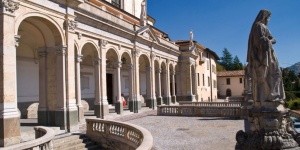
The Basilica dedicated to Santa Maria Assunta and San Giovanni Battista is the main place of worship in Clusone and was built between 1688 and 1698 on a design by Giovan Battista Quadrio, the architect of the factory of the Duomo of Milan.
It was solemnly consecrated in 1711 and in 1961 was awarded the title of Minor basilica by Pope John XXIII.
When you enter the Basilica, you find a treasure chest of rare beauty and a harmonious composition of different styles, in which each decorative element fits perfectly into the whole of the Baroque style: marble altars, gilded stuccos, sumptuous sacred vestments and canvases by the most important Lombard-Venetian artists. The statues on the sides of the altarpieces, the majestic main Altar and the Fantonian wooden group of the Crucifix are of renowned beauty.
The church’s façade is slightly salient and has no particular decorations: at the top, in the middle there is a rectangular window.
There is also a museum that can be visited on Sundays, public holidays and the days preceding these days, with free admission.
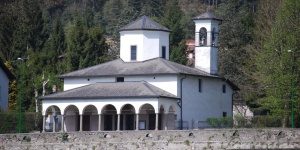
The Sommaprada Sanctuary is located on the road that connects Clusone to Rovetta, in the locality of Conca Verde, an area dominated by meadows and plants. Also known as the Sanctuary of Madonna dei Viandanti, it was erected in 1544, following the miracle of July 2nd, 1533, when the little chapel with the effigy of Our Lady suddenly illuminated to rescue a group of lumberjacks assailed by bandits.
On the walls, it is possible to see some of the gifts given to Our Lady from the pilgrims. On the external façade there is a fresco from 1921, depicting the image of the Virgin of Sommaprada with Rovetta in the background, while inside the Sanctuary there is a fresco from the late fifteenth century with the image of the Our Lady holding Jesus in her arms.
The Feast of the Apparition is celebrated on the 2nd July.
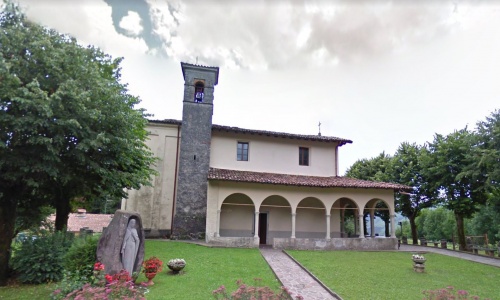
The ninth day will take you from Castione della Presolana, in the Seriana Valley, to the upper part of Lake Iseo and more precisely to Lovere, along a route of about 30km. In Dorga, a hamlet of Castione, you can visit the Sanctuary of the Madonna delle Grazie in Lantana and, on the road between Songavazzo and Cerete, in the hamlet of Novezio, you will come across the Sanctuary of the Nativity of the Blessed Virgin Mary. During this stage, you can admire the wonderful natural landscape of the Tede Valley and the historic centre of Songavazzo, characterised by rural and manor houses in perfect Orobic style. From here you will move towards Upper and Lower Cerete, up to Sovere, where the beautiful Sanctuary of the Blessed Virgin of the Tower is located. Crossing the valley of the Borlezza river you will then reach the Convent of the Capuchin Friars in Lovere. After admiring the view of the lake below, you will reach the historic centre of the village, the arrival point of this stage.
The ninth day will take you from Castione della Presolana, in the Seriana Valley, to the upper part of Lake Iseo and more precisely to Lovere, along a route of about 30km. In Dorga, a hamlet of Castione, you can visit the Sanctuary of the Madonna delle Grazie in Lantana and, on the road between Songavazzo and Cerete, in the hamlet of Novezio, you will come across the Sanctuary of the Nativity of the Blessed Virgin Mary. During this stage, you can admire the wonderful natural landscape of the Tede Valley and the historic centre of Songavazzo, characterised by rural and manor houses in perfect Orobic style. From here you will move towards Upper and Lower Cerete, up to Sovere, where the beautiful Sanctuary of the Blessed Virgin of the Tower is located. Crossing the valley of the Borlezza river you will then reach the Convent of the Capuchin Friars in Lovere. After admiring the view of the lake below, you will reach the historic centre of the village, the arrival point of this stage.
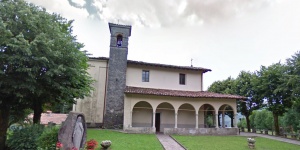
Located in the village of Lantana, in Castione della Presolana, the Lantana Sanctuary stands on the site of an old oratory dedicated to San Silvestro Papa, whose image is carved in stone on a slab that can be admired on the entrance door and in one of the presbytery paintings.
Over the centuries the structure has been damaged several times and what we can visit today is the result of the last reconstruction in 1909.
Inside there are two frescoes (now on canvas) from the fifteenth century: the fresco of the Madonna enthroned with Child, Christ Crucified and Saint Anthony the Abbot and the venerated image of the Blessed Virgin enthroned with the Blessed Child.
The Lantana Sanctuary is a pilgrimage destination, a site of devotion to the Blessed Virgin Mary, a tribute to her miracles handed down verbally and documented by the numerous gifts brought by the believers.

Close to the Trinale Valley, on the Cerete-Songavazzo provincial road, in the village of Novezio, is the Sanctuary of the Nativity of the Blessed Virgin Mary and it is part of the Parish Church of S.S. Filippo and Giacomo in Cerete Alto.
A small and fascinating building, an important testimony of faith and art, where you can admire numerous works of art: the vault frescoed by Brighenti in 1883, two paintings by Cifrondi dated 1710 and a painting in the altarpiece by Pietro Ronzelli from 1593.
In 1857, a furious fire devastated the whole structure. It isn’t possible to ascertain the origins of the sanctuary and the motivation behind its construction because all the documentation relating to the church was destroyed in the fire.
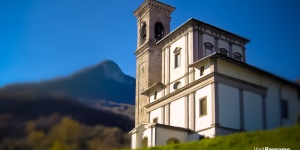
Madonna della Torre Sanctuary is considered one of the most ancient, besides one of the most beautiful, dioceses in Bergamo.
The story goes that its origins are due to Emperor Charlemagne, in the year 801. The inside church with nave and two aisles is a real picture-gallery, rich in very beautiful paintings, some of which very valuable.
The high altar, of polychromatic marble, modelled and inlaid by Fantoni, is surmounted in the middle by a little tribune with a fresco representing the Madonna.
There are several votive offerings, most of which covered the walls of the Angel Chapel, along the road towards the sanctuary, proving the centuries long trust set by the local believers in their Madonna.
It's faith that inspired the most ancient Marian prayers, still today among the most beautiful ones, in an extraordinary agreement with the hopes of whom rushes to Madonna della Torre Sanctuary: 'Under your protection we look for a shelter, Holy Mother of God, don't despise our supplications while we are undergoing the hardest trials, but rescue us from any danger, oh glorious and blessed Virgin'.
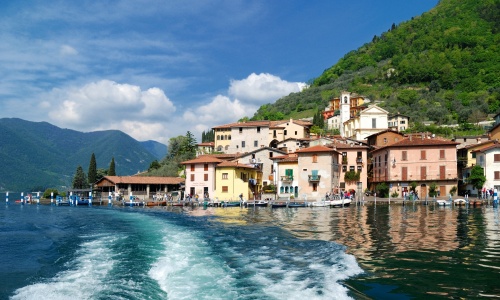
On the tenth day, from Lovere you will leave by ferry for Monte Isola, the largest lake island in Europe. In Lovere, you can visit the ancient Basilica of Santa Maria in Valvendra, while on Monte Isola you will walk the path that will lead you to the Sanctuary of the Madonna della Ceriola, the most panoramic point. You will then return by ferry to Lovere.
On the tenth day, from Lovere you will leave by ferry for Monte Isola, the largest lake island in Europe. In Lovere, you can visit the ancient Basilica of Santa Maria in Valvendra, while on Monte Isola you will walk the path that will lead you to the Sanctuary of the Madonna della Ceriola, the most panoramic point. You will then return by ferry to Lovere.
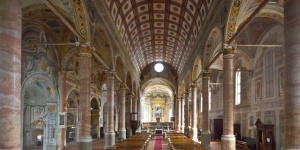
In Lovere we find the largest church in the Diocese of Brescia: The Santa Maria in Valvendra Basilica. The Basilica is located just outside the historic village of Lovere.
The church was intended as a votive shrine dedicated to the Our Lady of Graces by the families of Lovere and for the construction it was necessary to divert the Valvendra stream, from which it takes its name.
With a Gothic-Renaissance imprint, the exterior has a simple façade, preceded by a portico with 33 descending steps, symbolising the age of Jesus, and the interior is fascinating and majestic, completely frescoed.
There are numerous frescoes dedicated to the Trinity, painted in 1580, to St. Joseph and the Immaculate Conception painted in 1544 and in 1535 by Andrea da Manerbio and, finally, the paintings of the chapel of San Francesco, by Gian Giacomo Barbelli in 1647.
The organ is a fundamental part of the Basilica and is characterised by the doors painted by Floriano Ferramola with "The Annunciation" outside and inside you can admire the fresco of Saints Faustino and Giovita by Alessandro Bonvicino, called the Moretto.
The main marble altar was created by Andrea Fantoni. There is also a beautiful bell tower standing tall next to the church’s apse.
Free entrance.
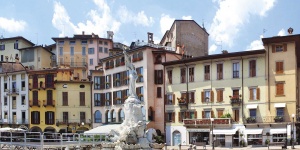
Lovere is a magical place: the best way to start visiting it is the lakefront road! ù
Its modern architectural layout enhances its natural beauty, making it a perfect location to enjoy both the lake view and the amazing facades of the town’s historical buildings.
It’s also a great place to relax or enjoy a delicious local meal: don’t miss the excellent fresh fish!
Explore the art and culture of this village by admiring the beautiful paintings and statues of the Accademia Tadini. If you’re more into science, go visit the collections of the Museo Civico Amighetti.
What’s the best way to finish your day in Lovere? A romantic sunset on the lakeside.
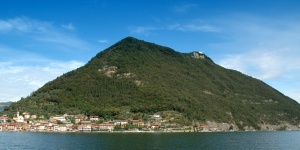
Likewise other small islands, Montisola maintained the old habits of people who live far from the mainland and the stress of the city.
The motor vessels headed to the island leave from the villages of Sulzano and Sale Marasino. Once you got to Montisola the small fishermen’s boroughs and their boats, called naèt, will immediately enchant you.
Take a look around and explore the alleys: cars are not allowed to circulate in the island, so you can enjoy it at its best by bike or by bus. Montisola’s perimeter is 11 kilometres long: you can walk it in about 3 hours and a half, to admire the natural landscapes and the lovely views of Bergamo and Brescia lakesides.
However, the most spectacular observation point is on the highest place of the island: at 600 meters in height you can find the Santuario della Ceriola. It’s quite a demanding walk, but it is really worth it!
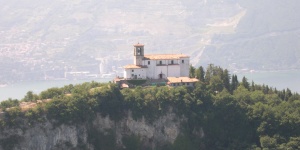
Located on Monte Isola, the largest lake island in the middle of Lake Iseo. It is located at the highest point of the lake and from there you can admire a wide view of the lake and the surrounding mountains.
The Sanctuary of Madonna della Ceriola was the first building worshipping Our Lady to be built in the Lake Iseo area, in fact, its origins date back to the mid-fifth century.
The name "Madonna della Ceriola", probably derives from the oak (cerro in Italian), used to build the twelfth century wooden statue, representing the Virgin enthroned with the Child in her arms, venerated inside the Sanctuary.
Inside the sanctuary there are numerous frescoes, paintings and ex-voto, the gifts from the faithful that recall the graces attributed to Our Lady.
Every second Sunday of July there is the "Madonna del Colera" celebration, in gratitude for the protection given to the inhabitants of the island against an 1836 cholera epidemic.
Today the sanctuary is the symbol of civil unity among all the citizens of the only municipality of Monte Isola, which carries in its emblem the figure of the Sanctuary of Madonna della Ceriola.
Getting there is simple. The sanctuary is served by a cobbled mule track that connects it to the locality Cure, and on Saturdays, Sundays and public holidays there is a bus service that starts near the pier of Peschiera Maraglio and stops in the locality of Cure.
Also from Peschiera Maraglio starts the path that leads to the Sanctuary and along the path are 15 chapels that celebrate the mysteries of the Rosary, built in the second half of the twentieth century.
During religious services, visits are suspended.
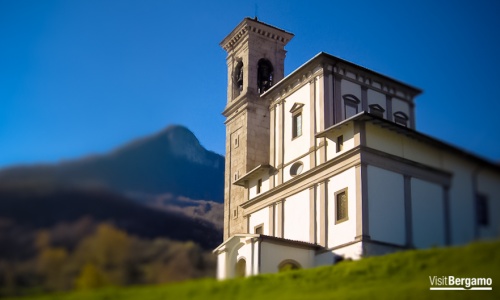
For the eleventh day of walking, from Lovere you will return to the Seriana Valley, and precisely to Gandino, along a 29km route immersed in numerous natural beauties. Given the length of the stage, the use of public transport is recommended for the transfer from Lovere to the Sovere convent. From here go up until you reach a small clearing where you will take the CAI path 563 to the Malga Lunga Refuge, home to the Museum of the Bergamasca Resistance. You will then reach the Sanctuary of the Madonna d’Erbia in Casnigo. A little further you will arrive near the Sanctuary of the SS. Trinity, defined as the “small Sistine Chapel of Bergamo”. The arrival of this stage is in Gandino, where there is the majestic Basilica of Santa Maria Assunta and you can find hospitality at the home of the Ursuline Sisters.
For the eleventh day of walking, from Lovere you will return to the Seriana Valley, and precisely to Gandino, along a 29km route immersed in numerous natural beauties. Given the length of the stage, the use of public transport is recommended for the transfer from Lovere to the Sovere convent. From here go up until you reach a small clearing where you will take the CAI path 563 to the Malga Lunga Refuge, home to the Museum of the Bergamasca Resistance. You will then reach the Sanctuary of the Madonna d’Erbia in Casnigo. A little further you will arrive near the Sanctuary of the SS. Trinity, defined as the “small Sistine Chapel of Bergamo”. The arrival of this stage is in Gandino, where there is the majestic Basilica of Santa Maria Assunta and you can find hospitality at the home of the Ursuline Sisters.
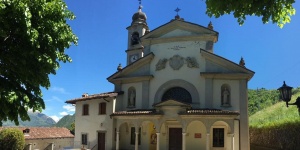
Located in Casnigo, on Mount Erbia, this sanctuary is testimony to the strong devotion to the Virgin Mary.
There are many legends concerning the origin of this sanctuary. According to one of the legends, a very revered image, depicting the Madonna del Presepe painted on the wall inside a local farmer’s house. The numerous pilgrims who came to worship the image trampled the grass of the surrounding fields and, so one evening, the annoyed farmer slashed the painting with a hoe, but it reappeared during the night.
Between the end of the eighteenth and the beginning of the nineteenth century a small church was erected, blessed in 1813. The wall of the farmhouse showing the venerated image was incorporated into the sanctuary.
The interior of the church is in Baroque style with a Latin cross plan and contains numerous artworks. The last cassock worn by the Holy Pope John Paul II is exhibited and preserved in a glass cas
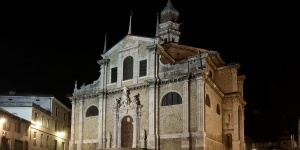
In the heart of Gandino’s historic centre, in Via Emancipazione, the Santa Maria Assunta Basilica is one of the most important architectural monuments in Bergamo.
Built in the fifteenth century to meet the needs of the constantly growing population, it was renovated in the early seventeenth century. The basilica was consecrated in 1654 and named after Santa Maria Assunta.
The exterior is a game of volumes using local tree stumps, highlighted in their geometric shape by pilasters and stone edges. There is a majestic Lombard lantern tower and a tall hexagonal bell tower with an onion dome.
The interior contains elements from the Venetian area, from the Central European area (one example is the bell tower’s onion dome) and of the Lombard area. There are numerous works of art preserved in the Basilica, for example the most important pictorial cycle of religious characters by Giacomo Ceruti, consisting of 40 paintings and frescoes.
Adjacent to the Basilica is the museum that collects numerous artworks and sacred objects, linked to the history of the building.
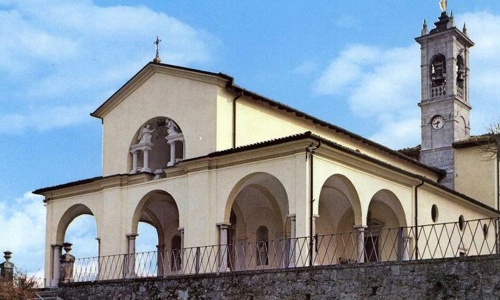
On the twelfth day, you will go from Gandino to Fiobbio. In Vall'Alta, in a panoramic position surrounded by woods, you will find the Sanctuary of Our Lady of Monte Altino and, going towards Fiobbio, in Cenate Sopra you will reach the Church of Santa Maria del Misma, a hermitage on the side of the mountain. Adjacent to the church there are two hostels where you can rest.
On the twelfth day, you will go from Gandino to Fiobbio. In Vall'Alta, in a panoramic position surrounded by woods, you will find the Sanctuary of Our Lady of Monte Altino and, going towards Fiobbio, in Cenate Sopra you will reach the Church of Santa Maria del Misma, a hermitage on the side of the mountain. Adjacent to the church there are two hostels where you can rest.
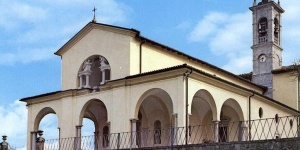
Located at an altitude of 850 metres on Monte Altino and on a crossroads between the valleys (Cavallina Valley to the east, Gandino Valley and Rossa Valley to the north, Seriana Valley to the west and Lujo Valley to the south) is the Sanctuary of Our Lady of Mount Altino.
The origins of the Sanctuary of Altino date back to the apparition of Our Lady on July 23rd 1496, on a hot day, during which an inhabitant of Vall'Alta prayed to Our Lady for water, and after the apparition of the Blessed Virgin a spout of water gushed like a spring from the rock.
At the back of the Sanctuary there is a small fountain where pilgrims can draw water as a gift from Mary.
On July 23rd the "Apparition" is celebrated.
Our Lady of Altino has her own special prayer.
Numerous artworks are preserved in the sanctuary, the most noteworthy are some frescoes attributed to Cristoforo Baschenis.
The Sanctuary is in a panoramic position, immersed in greenery and surrounded by woods creating a cosy environment.
It is open from Easter Monday to the Feast of the Immaculate Conception (December 8th)
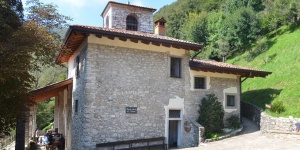
Located on the southern slope of Mount Misma, in the municipal territory of Cenate Sopra, the Church of Santa Maria Assunta di Misma is a fascinating sacred site built around the year one thousand.
A Romanic jewel straddling the Seriana Valley and the Cavallina Valley, reachable only on foot following the red and white signs for the Italian Alpine Club path 607.
The Romanesque architecture of the church is very simple. There is a small bell tower next to a single rectangular room, which has a portico on its exterior, built on the side façade.
The interior of the church is characterised by three arches with small semi-circular apses that divide it into four bays, the last of which encloses the altar located in a central position.
Adjacent to the church there are two hostels, where you can stay for one night.
It can be visited on Sundays and public holidays, with free admission.
You can book tours for large groups.
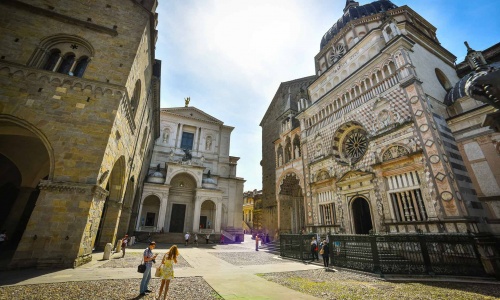
The last 27km of the Alta Via delle Grazie route will take you to Bergamo. Along the route from Fiobbio to Bergamo, you will reach Desenzano d'Albino, where you can visit the Sanctuary of Madonna del Miracolo della Gamba, an important symbol of the village and in Albino there is the Sanctuary of Madonna del Pianto, overlooking the city's crossroads. In Nembro you will stop at the Sanctuary of the Blessed Virgin Mary Mother of Mercy, or of Zuccarello and in Alzano Lombardo you can visit the San Martino Vescovo Basilica. In Bergamo, in Borgo S. Caterina, is the Sanctuary of Our Lady of Sorrows and, finally, you will reach the centre point of faith in the city and the final destination of the whole of the Alta Via delle Grazie Walk, the Santa Maria Maggiore Basilica in the Upper Town.
The last 27km of the Alta Via delle Grazie route will take you to Bergamo. Along the route from Fiobbio to Bergamo, you will reach Desenzano d'Albino, where you can visit the Sanctuary of Madonna del Miracolo della Gamba, an important symbol of the village and in Albino there is the Sanctuary of Madonna del Pianto, overlooking the city's crossroads. In Nembro you will stop at the Sanctuary of the Blessed Virgin Mary Mother of Mercy, or of Zuccarello and in Alzano Lombardo you can visit the San Martino Vescovo Basilica. In Bergamo, in Borgo S. Caterina, is the Sanctuary of Our Lady of Sorrows and, finally, you will reach the centre point of faith in the city and the final destination of the whole of the Alta Via delle Grazie Walk, the Santa Maria Maggiore Basilica in the Upper Town.
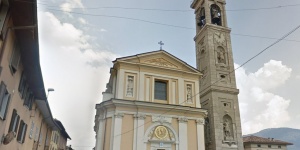
In Desenzano al Serio, fraction of Albino, there is the Sanctuary of Our Lady of the Miracle of the Leg (Miracolo della Gamba), a place of Catholic worship dating back to the eighteenth century.
Built to honour the miracle in 1440, performed on the young Venturina Bonelli, a girl with a serious leg infection, healed following the Apparition of Our Lady. The Sanctuary was built over a small pre-existing church (first it was the home of the young Venturina).
The church, with a rectangular plan, is accessible from the large churchyard. Outside there is a bell tower, built in the late nineteenth century, on top of which there is a 3.5 metre golden copper angel.
The interior of the church is a single nave and, below the altar, you can admire the sculptural representation of the miracle of the leg, by Andrea Fantoni. Along the walls are some paintings representing the apparition and the ex-voto, testimony of the gifts offered to Our Lady by the numerous pilgrims.
Beautiful frescoes cover the ceiling and the dome above the altar.
On 9th October a celebration of the Sanctuary is held, during which a fair is organised in the streets adjacent to the building.
It's open all year
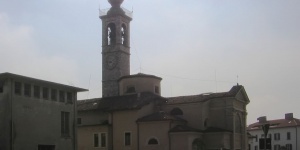
Located at the entrance to Albino, on the edge of the road to Clusone. Its origin does not date back to an apparition, but to a miracle that occurred in front of the statue of Our Lady of Sorrows, venerated in a chapel of the church.
The Sanctuary is the work of the architect Antonio Piccinelli and is given by the unification of two pre-existing sacred buildings, the Church of the Invention of the Holy Cross (before the eleventh century) and a dedicated chapel to Our Lady built in the sixteenth century.
The church has a Latin cross structure. Inside you can find paintings by Moroni, Salmeggia and Zucco, numerous votive offerings and the chapel of the Beata Vergine del Pianto.
The Sanctuary is a popular pilgrimage destination.
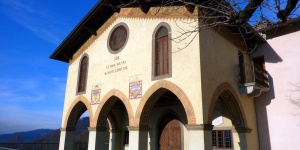
Located on a hill in Nembro, from the outside you can enjoy a very nice view over the entire valley. You can reach it by way of a not too demanding walk and along the mule track that goes up to the church there are statues depicting the Mysteries of the Rosary.
The Sanctuary of Madonna dello Zuccarello was founded in 1374 by the will of the nobleman Bernardo Vitalba and remained the property of the Vitalba family until the mid-nineteenth century.
Originally a simple chapel was built against the walls of the noble residence. The first expansion was made around the sixteenth century and the last dates back to the early decades of the twentieth century.
The external façade has a large portico with three pointed arches and the church inside is a single nave, divided into three bays.
There are numerous works of art preserved in the Sanctuary: numerous frescoes, such as the Nativity by Enea Salmeggia, the figures of San Donato and San Francesco by Francesco Cavagna and on the main altar the fresco called Our Lady of Sorrows, the Pietà whose creator's name is unknown, but we know only that they were of Bergamo origin.
In 2004 the restoration of the complex around the Sanctuary of Madonna dello Zuccarello was completed, where the patron saint’s day is celebrated on August 8t
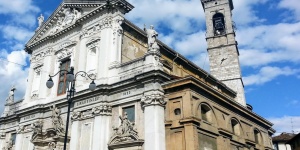
Located in the historic centre of Alzano Lombardo, just outside Bergamo towards the Serina Valley, the San Martino Basilica was awarded the title of Minor Basilica in 1922 by Pope Pius XI.
The first news concerning the basilica dates back to 1023, when the church was very small and the current structure dates back to the seventeenth century.
A three-nave building with five bays each and the central nave is the highest and widest.
There are eight chapels, each one dedicated to a saint or a sacrament. In each chapel there are sculptures, inlays and paintings.
Important pictorial cycles can be admired, including Agar by Giovanni Carnovali.
In addition to the San Martino Basilica, you can visit San Martino’s Museum of Sacred Art, located in the structure called Il Palazzo. The museum has 14 rooms that retrace the Basilica’s historical periods of its birth and development.
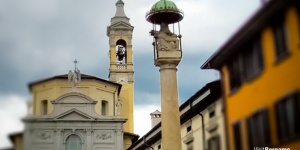
The Sanctuary of Our Lady of Sorrows is located in Borgo Santa Caterina in the lower part of the city of Bergamo.
The history of the church is linked to the extraordinary event of the appearance of a star that illuminated the fresco of Our Lady of Sorrows located on the facade of a house, where the Sanctuary was later built.
Construction works for the Sanctuary ended in 1605 and the following year the wooden statue of Our Lady of Sorrows was made, an exact copy of the fresco, which is still carried in procession through the neighbourhood’s streets on August 18th, a day that recalls the miraculous event of the Apparition.
Outside the church is a large churchyard and the building has a Greek cross plan.
On the main altar you can admire the fresco of the miracle. There are numerous sculptures and bas-reliefs of various qualities present in the sanctuary: for example, the twelve statues depicting twelve saints, by Antonio Rota.
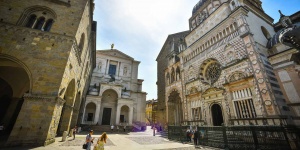
There’s a deep and old connection between the city and Santa Maria Maggiore Basilica, maybe due to the peculiar circumstances of its construction. During the first years of 1100, a terrible plague breakout spread across Europe, causing death and desolation. That’s why the people of Bergamo decided to ask the Virgin Mary to assist them: they vowed to dedicate a church to Her if she had protected them from being infected. Being men of their word, in 1137 Bergamo’s citizens started to built the Santa Maria Maggiore Basilica on the Piazza del Duomo, in the Upper Town. They actually acted big: the church turned out to be really beautiful, and it was adorned even more in the following centuries. Frescoes, stuccos, tapestries and wooden marquetry designed by the renowned artist Lorenzo Lotto decorate the inside of the building.
Santa Maria Maggiore also houses the funerary monument dedicated to Gaetano Donizetti, the famous music composer, symbol and representative of Bergamo all over the world.